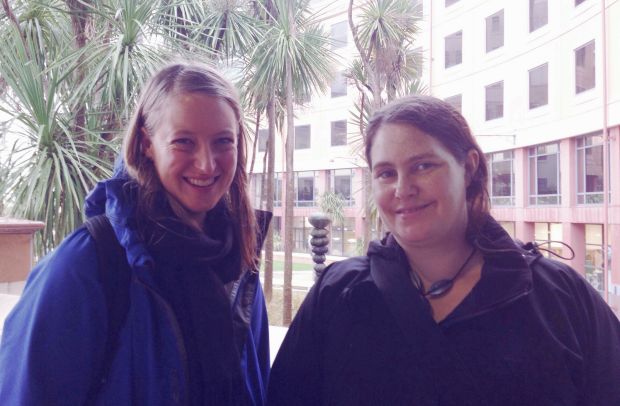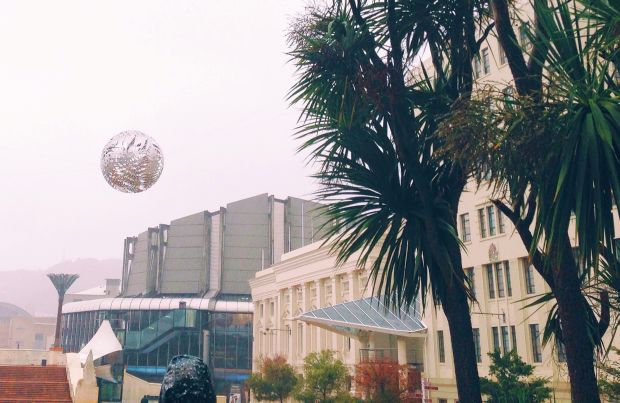
Rebeka Whale (left) and Maibritt Pederson Zari (right)
“We need nature in order to be well and healthy.”
– Pederson Zari.
From home grown vegetables to living walls, roof-top and pop-up gardens, to the humble indoor plant: nature is taking centre stage with gardening enthusiasts happily showing off the fruits of their back yard labour across Facebook and Instagram, and as it turns out, there is a global movement bringing architects and designers together to actively look for ways to incorporate 'green thinking' and the idea of sustainable living into the urban environment.
The role of nature in our inner cities has greater benefits beyond the aesthetic according to Maibritt Pederson Zari, Lecturer at Victoria University’s School of Architecture. She says that conscious decisions are made to bring habitat back into our cities, and it is even happening in Wellington – a living wall constructed from native plants has been created on the entrance to Civic Square.

Suspended fern sphere at Civic Square, Wellington
While green grass makes for a pretty picture, she says that plants, trees and natural light all contribute to our feeling of wellness: people tend to feel more sociable, less stressed and concentrate better in an environment with plants and trees. She notes that there have also been cases where people experiencing trauma or behavioural problems have been through successful rehabilitation through working with plants.
One of Pedersen Zari’s areas of research is Biophilia, which looks at the way in which humans gravitate towards nature, and then in turn, how designers can explore ways of incorporating nature into interior and exterior spaces. ‘Constructions of nature’ – sculptures, objects and anything that reminds of nature – is just as effective.
Bringing the outside indoors can be equally as beneficial, and even one indoor plant can make a difference on psychological health; contributing to greater productivity, mental clarity and relaxation. “Because plants are really good at engaging our senses, they are really good at creating spaces that are healing or relaxing,” she says.
Creative Project Coordinator Rebeka Whale is the founder of Wellington Living Architecture, and is an advocate of working with plants and bringing them into our workspaces and homes. She says that if you’re looking for a good indoor plant ‘Spider plants’ (Chlorophytum comosum) are a great one to start with because they’re incredibly resilient, self-propagating and they also improve air quality – battling benzene, formaldehyde, carbon monoxide and xylene, which are solvents used in the leather, rubber and printing industries.
Whale has a design background which she has successfully integrated with her love of plants and passion for environmental sustainability and well-being. She has helped to transform various spaces around Wellington, and setting up Wellington Living Architecture has been a way for her to look at the bigger picture and bring like-minded individuals together to generate further discourse and engagement around ideas of sustainability and the living environment. “I’d love to set up a demonstration rooftop garden,” she says, adding that it is largely dependent on sourcing the most suitable space and having some keen helpers to drive it.
Youtube video showing Rebeka Whale helping to transform Biz Dojo
A few businesses in Wellington are cultivating their own rooftop gardens – Nikau Café being one example of a business that produces some of their own herbs and vegetables – a means to gain independence during periods when some varieties aren’t always available.
Whale would love for everyone to bring plants into their homes and working spaces, but she knows that it isn’t as easy as it sounds. Plants can be expensive and she has a project in mind to help alleviate that problem. She wants to create a plant exchange, or place that people can come and donate unwanted plants for those who either can’t afford them or have trouble accessing them. Inner city dwellers, especially, are among those who have limited access to garden centres and nurseries, which are otherwise found in suburban areas.
“Plants transform a space. Aesthetically they make a space feel softer, they create atmosphere and some delight for the eye,” she says.
Links:
Wellington Living Architecture
International Living Futures Institute
Top Indoor House Plants

